Diamonds Don't Wear...or Should They?
Diamond is well recognized as the hardest substance known to man. One would think that an operator of a sawing machine could utilize the hardness characteristics of diamond to maximum advantage (i.e., the harder the better). In practice, this is not always true. Whether the operator is cutting stone, masonry or concrete, the diamonds must wear in order to maximize the performance of the cutting tool. This article will examine the role diamond plays in cutting tools and how an operator can use analytical methods to maximize the use of the diamond cutting tools, thereby increasing productivity and maximizing tool life.
Diamond Crystals & How They Work
Diamond crystals can be synthetically grown in a wide variety of qualities, shapes, toughness and sizes (Figure 1). Synthetic diamond has replaced natural diamond in virtually all construction applications because of this ability to tailor-make the diamond for the specific application.
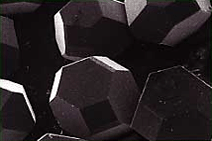 Figure 1 - Tough cubo-octahedral diamond crystals |
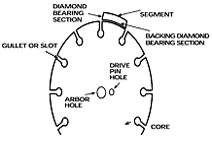 Figure 2 - Diamond blade components |
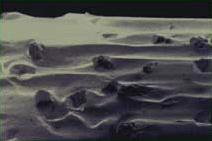 Figure 3 - Bond tail formed behind the diamond |
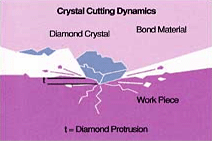 Figure 4 - Diamond crystal cutting dynamics |
A diamond saw blade is composed of a circular steel disk with individual segments or a continuous rim containing the diamond attached to the outer perimeter of the blade (Figure 2). The diamonds are held in place by a metal bond matrix, which is a specially formulated mixture of metal bond powders and diamond that has been pressed and heated in a sintering press. The exposed diamonds on the surface of the segment do the cutting. A diamond blade cuts in a manner similar to how sandpaper cuts wood. As the blade cuts, bond tails are formed that trail behind each diamond (Figure 3). This bond tail provides mechanical support for the diamond crystal. As the blade rotates, the diamonds chip away at the material being cut.
Contrary to a popular advertising campaign, a diamond is not forever. The exposed diamond cutting points eventually wear away, and if not for some provision to replace these cutting points, the blade or bit would soon be useless. This process is actually desired as it provides a new layer of diamond crystals to continue the cutting action (Figure 4).
Blade Operating Speeds
Manufacturers produce blades for specific applications. They recommend operating speeds or a maximum operating speed for that blade and print this information directly on the blade. Recommended operating speeds are based on blade size, equipment type and the type of material being cut (Figure 5). The American National Standards Institute (ANSI) Code B7.1 and B7.5 guidelines set maximum operating speeds. Never operate a blade above the maximum or "Do Not Exceed" revolutions per minute (RPM) stamped on the blade. Failure to comply with this warning is dangerous and can result in injury or death.
| Blade Diameter (inches) |
Blade Diameter (mm) |
Opera Speed (RPM) |
Maximam Safe Speed (RPM) |
|
4 4½ 5 6 7 8 9 10 12 12 High Speed 14 14 High Speed 16 18 20 22 24 26 28 30 32 36 42 48 |
102 114 127 152 178 203 228 254 305 305 High Speed 356 356 High Speed 406 457 508 558 610 660 711 762 813 914 1,067 1,219 |
9,072 8,063 7,257 6,048 5,184 4,536 4,032 3,629 3,024 6,300 2,592 5,400 2,268 2,016 1,814 1,649 1,512 1,396 1,296 1,210 1,134 1,008 864 756 |
15,000 13,300 12,000 10,000 8,500 7,580 6,800 6,100 5,100 6,300 4,400 5,400 3,800 3,400 3,008 2,800 2,588 2,300 2,300 2,080 1,900 1,800 1,500 1,200 |
When in doubt about the correct operating speed for a particular material, it is better to choose a lower speed rather than a higher speed. Once the blade is cutting well, the speed can be increased to optimize the life of the diamond blade.
Material to be Cut
Knowing as much as possible about stone, brick, block, ceramic or combinations of these masonry materials can be of enormous benefit to the cutting operator and the tool manufacturer.
Blades used to cut hard masonry materials should have segments with tough diamonds and a soft metal bond matrix. Otherwise, the diamond particles will wear even with the bond surface and the blade will glaze over and be unable to cut. Likewise, segments for cutting soft materials should have hard metal bonds so that the diamond particles are not lost before their cutting life is used up.
Troubleshooting
In the early days of cutting there were many misconceptions based upon a lack of technical knowledge. The introduction of synthetic diamond has allowed the industry to advance its technology and professionalism; however, there are still a number of common problems encountered in the field today.
Loss of Tension
The loss of tension in a diamond blade can be caused by many factors. The blade core could have become overheated from a lack of sufficient water being applied to the blade or a lack of side clearance that results from uneven segment wear. The operator should check that the water supply is adequate and that it is reaching the core near the collars and sheeting out to the cutting area. The operator should use a blade with more side clearance and suited to the cutting application.
Blade tension may also be lost when a blade is not aligned correctly on the saw, the blade flanges are not of the proper size, or the blade is not properly mounted on the arbor shoulder, causing the blade to bend when the flanges are tightened. The operator should make certain that the flanges are clean, the proper size, and properly mounted and secured.
Segment Loss
Overheating of the blade can cause segment loss. This is often the result of a lack of enough water being applied to the cutting area. Another reason for segment loss may be that the blade specification is too hard for the material being cut, causing the blade to become dull. In this instance, an operator should recognize that the material being cut is different than originally believed and a blade with a softer bond might be better suited to the new material. Segment loss can also occur when the blade is subjected to sharp, sudden movements while in the cut or upon initiation of the cut. The operator should make slow and even contact between the blade and the material being cut.
Core Cracking
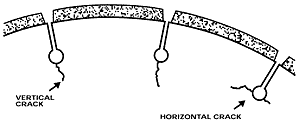 Figure 6 - Core cracking |
Blade will not Cut
A blade that will not cut can be the result of a number of factors. The first is that the blade specification may not be the proper one for the material being cut. The operator should examine the segments on the diamond blade with a loupe to find out why the blade is not cutting. If the operator finds that the surface of the segment is smooth and that the diamonds are not protruding, then the diamonds may be too friable, the bond too hard or the speed of the blade may be too high. On the other hand, if the operator finds that the diamonds are protruding too far from the bond with little bond support, then the bond is not resistant enough for the abrasive material being cut, or possibly the diamond/bond combination is not right for the application.
 If the operator examines the segment surface and finds that many of the diamonds are missing, then it is safe to assume that the diamond impact resistance is not sufficient or the combination of the diamond/bond is not right for the cutting application. The operator may find the diamonds in place but with an abnormally high amount of fractured or crushed crystals. The blade may cut fast initially, but its overall life is short because the diamonds are too friable or the blade has been subjected to excessive pounding.
If the operator examines the segment surface and finds that many of the diamonds are missing, then it is safe to assume that the diamond impact resistance is not sufficient or the combination of the diamond/bond is not right for the cutting application. The operator may find the diamonds in place but with an abnormally high amount of fractured or crushed crystals. The blade may cut fast initially, but its overall life is short because the diamonds are too friable or the blade has been subjected to excessive pounding.
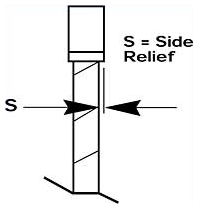 |
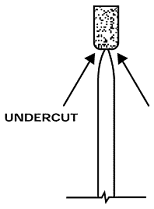 |
Another scenario is that the blade cuts well initially but then slows and eventually stops. The operator may find that the diamonds are in place, but are smooth or have flat tops and are still protruding above the bond surface. In this case the diamond may be too impact-resistant, too large a mesh size, too high a concentration, or the diamonds may just not have been pushed to their designed operating condition.
Field Performance
The information presented provides the background on how diamond blades should perform. But once the blade is in the field, it is up to the cutting operator to apply a blade to the job at hand in a profitable manner (Figure 7). An operator should regularly inspect for lost segments, uneven segment wear, developing cracks in the segment or steel core, undercutting, overheating, proper diamond exposure, loss of tension and arbor hole/drive pin distortion. Common equipment maintenance items such as blade flanges, blade shaft bearings, alignment of the axle and water delivery system should also be regularly checked. These actions will help ensure continued optimum performance in a safe manner.
| VARIABLES | CONDITION | CUTTING SPEED | BLADE LIFE |
| BOND HARDNESS | HARDER | SLOWER | LONGER |
| SOFTER | FASTER | SHORTER | |
| DIAMOND QUALITY | LOWER | SLOWER | SHORTER |
| HIGHER | FASTER | LONGER | |
| DIAMOND CONCENTRATION | LOWER | FASTER | SHORTER |
| HIGHER | SLOWER | LONGER | |
| SEGMENT WIDTH | THINNER | FASTER | SHORTER |
| THICKER | SLOWER | LONGER | |
| HORSEPOWER | LOWER | SLOWER | LONGER |
| HIGHER | FASTER | SHORTER | |
| BLADE RPM | LOWER | FASTER | SHORTER |
| HIGHER | SLOWER | LONGER | |
| WATER FLOW | LOWER | FASTER | SHORTER |
| HIGHER | SLOWER | LONGER | |
| CUTTING DEPTH | SHALLOW | FASTER | LONGER |
| DEEP | SLOWER | SHORTER | |
| MATERIAL HARDNESS | HARDER | SLOWER | LONGER |
| SOFTER | FASTER | SHORTER | |
| ABRASIVENESS | MORE | FASTER | SHORTER |
| LESS | SLOWER | LONGER | |
| AGGREGATE SIZE | LARGER | SLOWER | SHORTER |
| SMALLER | FASTER | LONGER | |
| STEEL REINFORCEMENT | LESS | FASTER | LONGER |
| MORE | SLOWER | SHORTER |
Conclusion
The proper use of a diamond blade requires more than just a good diamond blade and a machine. It requires the skills of a professional operator with the knowledge to effectively utilize the tools in conjunction with the analytical skills learned either on the job or in formal training programs.
For optimum performance of a diamond blade this article has shown that, in addition to a trained operator, diamond "wear" is a good and necessary characteristic. If diamonds do not wear, they are of little value in a construction application. While a gem diamond may last forever when "worn" on a woman's finger, a synthetic diamond for a construction application is only of value when it is wearing away!
About the Author
Patrick O’Brien is the Executive Director for the Concrete Sawing and Drilling Association.
This article was prepared utilizing information from the Concrete Sawing and Driling Association (CSDA) Cutting Edge and CSDA Operator Certification training manuals. CSDA is a nonprofit trade association of contractors, manufacturers and affiliated members from the construction and renovation industry. For more information about CSDA and its training programs, call (727) 577-5004 or visit www.csda.org.















